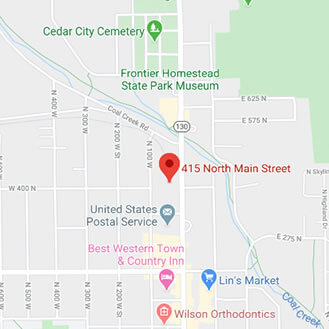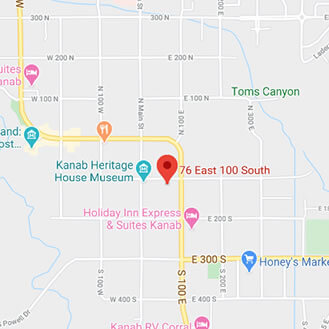May 18th, 2022

Analyzing strong points, looking for potential problems, making comparisons—it’s bracketology time! Nope, not basketball (although we hear they have something similar), but a brief analysis of your orthodontic options when it comes to choosing a winning bracket.
If you’re getting braces, you’re probably already familiar with how they work—brackets are bonded to the teeth to hold an archwire, which provides gentle, controlled pressure to move the teeth into alignment. But within that basic bracket-and-wire system, there are several different bracket designs available to you at our Cedar City or Kanab, UT orthodontic office. Let’s see what the scouting report has turned up on our final four, pointing out their distinct advantages as well as some potential mismatches.
Traditional metal brackets
Advantages:
- Traditional braces with metal brackets are effective for more than just straightening teeth. They can be used to correct rotated teeth, differences in tooth height, and bite problems. For severe bite and alignment problems, traditional braces are most often the right choice.
- Metal construction makes these brackets able to handle the controlled pressure needed to treat serious malocclusions.
- Cost-effective. These are usually the least expensive option.
Potential Disadvantage:
Clear/Ceramic Brackets
Advantages:
- Lack of visibility! Whether you go for clear brackets or brackets tinted to match your enamel, you’ll be keeping a low-profile with this choice.
- Stronger and more stain-resistant than ever before, using the latest in ceramic, porcelain, or plastic materials.
Potential Disadvantages:
- Not as durable. Unlike metal, these clear brackets can crack or break. If you play a contact sport, these might not be for you.
- Some ceramic brackets are larger than other choices, so might be recommended only for the top teeth.
- Clear or tinted brackets can be more expensive.
Self-Ligating Brackets
Advantages:
- These brackets use a clip or trapdoor mechanism to hold your archwire without the need of bands. Ceramic options are available if you want an even more discreet appearance.
- Can be more comfortable with less friction between wire and bracket.
Potential Disadvantages:
- Self-ligating braces are generally more expensive.
Lingual Braces
Advantages:
- Lingual braces use metal brackets, but they attach to the back of each tooth for almost invisible bite correction.
- Custom-made. Lingual brackets can be designed and fabricated to fit your individual teeth perfectly.
Potential Disadvantages:
- Trickier to clean because of their placement behind teeth.
- Might not be suitable for a deep bite if there’s not enough clearance between top and bottom teeth.
- Initial discomfort caused by the tongue’s contact with the braces when you speak and eat.
- Custom-made brackets are more expensive.
So that’s a brief rundown of your bracket choices. But, unlike sports bracketology, there are no losers here! Dr. Mark Webster can give you the pros and cons of each bracket design, so you can make an informed decision based on the kind of braces which will work best for you. With coaching like that, no matter which bracket option you choose, the final result is the same—a winning smile!
May 11th, 2022

Parents usually have numerous questions about orthodontic treatment for their children. According to the American Association of Orthodontists, orthodontic treatment for children should start at around seven years of age. This allows Dr. Mark Webster to evaluate the child’s existing and incoming teeth to determine whether or not early treatment might be necessary.
What is early orthodontic treatment?
Early orthodontic treatment, known as Phase One, usually begins when the child is eight or nine years old. The goal is to correct bite problems such as an underbite as well as guide the jaw’s growth pattern. It also helps to make room in the mouth for the permanent teeth to be properly placed as they come in. This will greatly reduce the risk of the child needing extractions later in life due to his or her teeth getting crowded.
Does your child need early orthodontic treatment?
There are several ways that you can determine whether your child needs early treatment. If you observe any of these characteristics or behaviors, you should talk to Dr. Mark Webster.
- Early loss of baby teeth (before age five)
- Late loss of baby teeth (after age five or six)
- The child’s teeth do not meet properly or at all
- The child is a mouth breather
- Front teeth are crowded (you won’t see this until the child is about seven or eight)
- Protruding teeth, typically in the front
- Biting or chewing difficulties
- A speech impediment
- The child’s jaw shifts when he or she opens or closes the mouth
- The child is older than five years and still sucks a thumb
What are the benefits of seeking orthodontic treatment early?
Early orthodontic treatment is begun while the child’s jaw bones are still soft. They do not harden until the children reach their late teens. Because the bones are still pliable, corrective procedures such as braces work faster than they do for adults.
In short, early treatment at our Cedar City or Kanab, UT office often allows your child to avoid lengthy procedures, extraction, and surgery in adulthood. Early treatment is an effective preventive measure that lays the foundation for a healthy, stable mouth in adulthood.
May 4th, 2022

The merry month of May also happens to be National Fitness and Sports Month, so take advantage of the warmer days to get outside and exercise! Bringing a friend, family member, or coworker with you when you go for a brisk walk during a lunch break can provide an opportunity to socialize as well as health benefits. If you need a little more motivation, here are some good reasons to stay active and fit.
Exercise provides:
- Improved stamina and energy as well as toned muscles and bone strength and density
- Improved circulation and breathing for a healthier heart and lungs
- Reduced risk for Type 2 diabetes and certain forms of cancer
- For older adults, regular exercise may help improve balance and reduce the risk of falls as well as improved cognitive abilities
Children and Teens
Children and teenagers spend long hours at their desks in school, on the computer, watching television, and involved in other sedentary activities that result in obesity and poor health later in life. Getting them engaged in school or community sports teams can help them form good life-long exercise habits. One important note: If they are participating in contact sports, Dr. Mark Webster and our team at Webster Orthodontics recommend your kids wear an approved mouthguard to protect those valuable teeth from injury! Ask us for a proper fitting of your safety appliance during your next visit!
A gym membership is nice but not necessary to stay fit; try these easy ways to work some exercise into your daily routine.
At Home
- Take a friend along for company on a walk through your neighborhood.
- Pursue gardening or other yard work, including mowing or raking.
- Take your kids on a bike ride or have them push a baby stroller around the block.
Couch potatoes take note: simply moving from the sofa to the floor for some sit-ups, leg-lifts, or push-ups while you’re watching television can help you get in better shape in no time.
At Work
- Take the stairs instead of the elevator.
- Take exercise breaks for walks around the building or parking lot.
- Walk or ride a bike to work.
So what are you waiting for? Get moving!
For more information on exercise techniques, or to schedule an appointment with Dr. Mark Webster, please give us a call at our convenient Cedar City or Kanab, UT office!
April 27th, 2022

You may have noticed that kids seem to be getting braces and other orthodontic care a lot earlier these days. There was a time, only a decade or two ago, when braces were mainly seen on teenagers, but that is beginning to change. If you’re wondering when to bring your child to our Cedar City or Kanab, UT office for an orthodontic evaluation, the answer actually has several parts.
The Telltale Signs
If your child has a very crowded set of adult teeth coming in, or if the permanent front teeth came in very early, these are signs that your child should see Dr. Mark Webster, regardless of age.
The Dental Age
Barring signs of trouble or early adult teeth as mentioned above, the time that your child needs to be seen for initial orthodontic evaluation depends not so much upon your child’s actual age, but on what is known as a “dental age.”
The dental age of the patient might be entirely different from his or her actual chronological age; for example, an eight-year-old could have a dental age of 13. It is part of Dr. Mark Webster and our staff’s job to determine the dental age and then make appropriate recommendations for the resolution of orthodontic issues if they are emerging.
The Official Recommended Age
The American Association of Orthodontists officially recommends that kids should see an orthodontist for the first time between the ages of seven and nine. Even if the child does not have all his or her permanent teeth, the teeth growth pattern can usually be predicted quite effectively by an orthodontist.
This allows for a proactive response to emerging problems, and this is the reason that some younger children are now getting orthodontic devices earlier in life. If a young child has serious orthodontic issues emerging, Dr. Mark Webster can usually address the problems immediately and then follow up with another round of treatment when the child has all the adult teeth.






